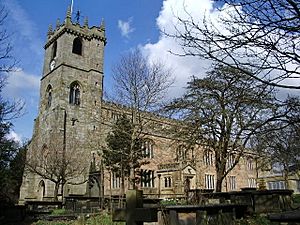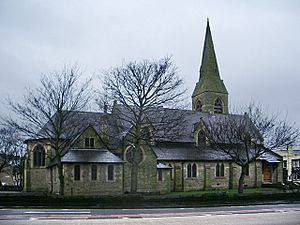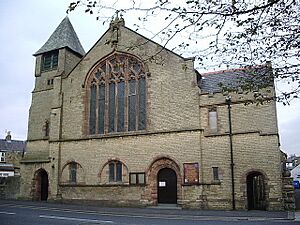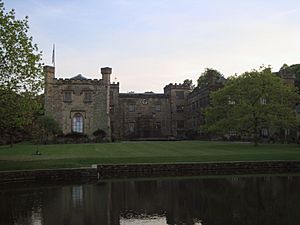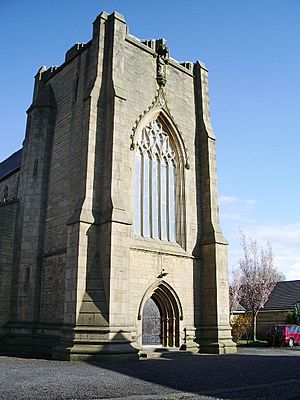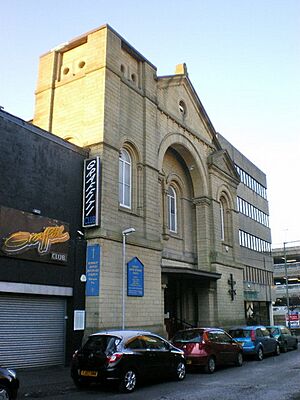Places of worship in Burnley facts for kids
Burnley, a town in Lancashire, England, has a long and interesting history of religious worship. People have gathered to worship here for a very long time, even before the year 1122, especially for the Church of England. For many years, the chapel at Towneley Hall was the main place for Roman Catholic worship in Burnley.
Before the Industrial Revolution, many different Protestant churches, known as non-conformist churches, started to appear in the town. In 1891, a very important meeting happened in Burnley that led to the creation of the Baptist Union of Great Britain and Ireland. Later, in the late 1800s, a Jewish synagogue was built. More recently, new evangelical and free churches have opened, and a large, specially built mosque was completed.
According to the 2001 census, most people in Burnley are Christian (74.5%), followed by Muslim (6.6%), and Hindu (0.3%). About 11% of people said they had no religion.
Records show there have been at least 77 Christian places of worship in Burnley. These include churches from many different Christian groups, such as Anglican, Baptist, Congregational (now United Reformed Church), Methodist, Roman Catholic, and others.
The largest place of worship in Burnley is Life Church Lancashire, located on Sycamore Avenue. They finished building their new church, which has a large hall that can seat 500 people, in November 2014.
Burnley has 17 religious buildings or structures that are considered "listed buildings" by English Heritage. This means they are important historical buildings and are protected. All of them are Grade II listed.
Contents
Anglican Churches
St Peter’s Church
St Peter's Church is the oldest church in Burnley, and the town actually grew up around it. The building you see today was mostly built in the 1400s and is a very important Grade II* listed building. St Peter's is located near the River Brun. There was a church on this spot even before 1122, but much of it was rebuilt in the 1530s. The oldest part of the church, the bottom of the tower, is from the 1400s or 1500s. Over the years, parts of the church were added or rebuilt to make space for more people, and it was restored in the 1800s.
St Andrew’s Church
St Andrew's Church on Colne Road was built in 1866–67. It was later restored in 1898. This church is also a Grade II listed building. A special area for baptisms was added in the 1900s. Most of the beautiful stained glass windows were made by an artist named Kempe. St Andrew's serves a diverse area of Burnley.
St Matthew’s Church
St Matthew's Church, on St Matthews Street, was built between 1876 and 1879. Sadly, on Christmas Day in 1927, the church was destroyed by fire, with only the walls left standing. It was rebuilt between 1929 and 1931. The church started as a small mission school in 1835. In 1985, it took over the parish of Holy Trinity. St Matthew's welcomes everyone for baptisms and marriages, and people from any Christian group can take communion there.
St Catherine’s Church
St Catherine’s Church, on Todmorden Road, was founded in 1899. It does not have a graveyard. The church was originally planned to be called St Alban's but changed its name when it opened in 1897. St Catherine’s is a late Victorian church with interesting Byzantine-style features. It has a beautiful stone exterior and a decorative brick interior with a wooden ceiling, offering a clear view of the main altar. The church also has a memorial to Victor Smith, who was awarded the Victoria Cross. They often have "Heritage Open Days" for visitors.
Other Anglican Churches
- St Mark’s Church on Owen Street was founded in 1909 and closed in 1965. A second St Mark’s, on Rossendale Road, was founded in 1965. Neither had a graveyard.
- St Stephen’s Church on Oxford Road was founded in 1865. It started as a mission, and a school and chapel were built in 1870. It does not have a graveyard.
- St Cuthbert’s Church on Towneley Street was founded in 1905. It does not have a graveyard. This church is very active in the community, supporting groups like Beavers, Cub Scouts, Scouts, Rainbows, Brownies, and Girl Guides. They also have a Mothers’ Union, a luncheon club, a table tennis group, and an amateur operatic and dramatic society. Many other groups use the church facilities, and all religious services are open to everyone.
- All Saints with St John the Baptist’s Church was built in 1845. Its graveyard closed in 1885. The church later joined with St. John's Gannow to form the West of Burnley Parish. The church has many interesting stained glass windows, including a creation-themed east window designed by local artist Brian Clarke.
Former Anglican Churches
Several Anglican churches in Burnley have closed over the years.
- St James’ Church on Bethesda Street was founded in 1844. The original building was demolished in 1969, and the site became a garden. Its tower and spire were also demolished in 1998 to make way for a shopping complex. A second St James’ church on March Street, founded in 1966, closed in 1998.
- St Alban’s Church on Stoneyhurst Avenue was founded in 1959 and closed in 1982, combining with St Catherine's.
- St John the Baptist’s Church on Gannow Lane was founded in 1868 and closed in 1981. The building was demolished in 1979, but a Church Centre still exists.
- St Margaret’s Church on Abel Street was founded in 1997 and closed in 1968, then demolished in 1969.
- St Oswald’s Church on Ighten Road was founded in 1910 and closed in 1980.
- St Paul’s Church on Saunder Bank was founded in 1845 and closed in 1961, with its parish combining with St Catherine's. The church was demolished in 1963.
- Holy Trinity Church on Accrington Road was founded in 1835 and closed in 1989, becoming flats. Its parish combined with St Matthew's.
- St Saviour’s Church in Church Street closed in 1954.
- Other former missions and churches include St Ayden Mission and St Columba’s Church.
Roman Catholic Churches
Towneley Chapel
The chapel at Towneley Hall was the main place for Roman Catholic worship in Burnley for a long time, from before 1706 until it closed in 1872. The Towneley family, who owned the hall, were Catholic and had a private chapel there for centuries. During the time of Queen Elizabeth I, they even had secret hiding places, called "priest holes," in their house for priests to hide. The Towneley family also helped start one of the oldest schools in the diocese in Burnley, which began as a Sunday school in 1798.
St Mary of the Assumption
St Mary of the Assumption Roman Catholic Church, on Yorkshire Street, opened in August 1849 with a grand ceremony. Many bishops were present, and a special Mass was celebrated with music. The convent next to the church was founded in 1872.
Other Roman Catholic Churches
- Christ the King Roman Catholic Church on Healey Court was founded in 1929. It does not have a graveyard.
- St Augustine’s Church on Lowerhouse Lane was founded in 1896. It started as a mission and faced challenges, even being closed and put up for sale at one point. It received a new baptismal font in 1947.
- St John the Baptist on Bracewell Street was founded in 1892. It began as a mission above a blacksmith's shop. A new church was built in 1908.
- St Mary Magdalene was founded in 1883 on Haslam Street and moved to a new church on Gawthorpe Road in 1980. It received significant support from St Mary's and the Towneley Family.
Baptist Churches
Aenon Chapel
Aenon Chapel, on Red Lion Street, was built between 1850 and 1852. It has an Italianate style, which means it looks like buildings from Italy. The name "Aenon" comes from a Biblical place near Salem where John the Baptist baptized Jesus, and it means "spring" or "natural fountain." Baptists were in the Burnley area by 1760. A very important meeting happened at Aenon Chapel in 1891, which led to the creation of the Baptist Union of Great Britain and Ireland, uniting different Baptist groups. The church closed in 1987 and the building was later used as a nightclub. In 2010, it was saved by the local health service to provide dental services.
Other Baptist Churches
- Ebenezer Chapel on Colne Road was founded in 1878 and had a graveyard.
- Immanuel Chapel on Bright Street was founded in 1895 and closed in 1970. The building is now used for businesses.
- Mount Olivet Chapel on Broughton Street/Plover Street was founded in 1893 but has since been demolished.
- Mount Pleasant Chapel on Hammerton Street was founded in 1858 and closed in 1997, moving to Rosehill Road.
- The church at Healey Grange, Rosehill Road, was founded in 1997.
Particular Baptist Churches
Jireh Chapel
Jireh Chapel, on Boot Way, was built in 1858 for a Baptist group called the "Gadsbyites." It is a small, rectangular building and is a Grade I listed building, meaning it's very important historically. The building is no longer used as a church and is reported to be just an empty shell inside. It does not have a graveyard.
Sion Baptist Chapel
Sion Baptist Chapel, on Church Road, started in 1827 as a school. The first chapel was built in 1830 with a burial ground. This chapel was rebuilt in 1862. In 1960, the church moved to a new chapel on Church Street, and the old one was demolished for a new road.
Methodist Churches
Methodism arrived in Burnley before 1787. The Central Methodist Church was founded in 1788. Today, the Burnley Methodist Circuit has nine active churches in the town and nearby areas.
United Free Methodist Churches
In 1907, several Methodist groups merged to form the United Methodist Church.
- Claremont Street Chapel was founded in 1891 and closed in 1961. It was later used as a furniture showroom.
- Salford Street Chapel was founded before 1895.
- Brunswick Chapel on Manchester Road was founded in 1869 and closed in 1962, then demolished in 1963.
- Hanover Chapel on Old Hall Street was founded in 1878 and is now closed, used by a plumbing supplier.
- Healy Wood Chapel on Lincoln Street was founded in 1883 and is now closed.
- Mount Pisgah Chapel on Myrtle Bank was founded in 1834 and closed in 1971, replaced by Parkside Methodist church.
- Mount Pleasant Chapel on Hammerton Street was founded in 1835 and closed in 1869, moving to Brunswick Chapel.
Wesleyan Methodist Churches
The Wesleyan Methodist Church was a large Protestant group in the 1800s. In 1932, they joined with other Methodist groups to form the Methodist Church of Great Britain.
- Brooklands Road chapel was founded in 1883 and closed in 2002.
- Lower Lane Chapel (or Lowerhouse Chapel) on Greenbrook Road was founded before 1846. In 1984, its congregation joined with Rosegrove to form Greenbrook Methodists.
- Manchester Road church was founded before 1893, with the main church opening in 1905. When the church was demolished, flats were built, but the spire was saved as a landmark.
- Stoneyholme Chapel on Hubie Street, founded in 1880, is now a plumbing warehouse.
- Whittlefield Chapel on the High Street was founded in 1873.
- The New Central Methodist Church opened in 1967.
- Fulledge Chapel in Todmorden Road was founded in 1861 and closed in 1959. It was destroyed by fire in 1985 and demolished in 1992.
- Lane Bridge chapel on Parker Lane was founded in 1865 and demolished before 1989.
- The Queensgate Chapel on Colne Road was founded in 1909 and closed in 1968. It later became a Pentecostal church and is now an Islamic center.
- Rosegrove Methodist Chapel on Gannow Lane was founded in 1863 and closed in 1984. It was later demolished after fire damage.
- The Rosehill Mission on Robert's Row was founded before 1873.
- Wood Top Chapel on Florence Street was founded in 1878 and is now closed and demolished.
- Park Hill Chapel on Padiham Road was founded in 1826 and closed in 1952.
- Accrington Road church was founded in 1849 and closed completely in 1971 due to dry rot.
Primitive Methodist Churches
- Curzon Street Chapel was built in 1833 and opened in 1834.
- Bethel Chapel on Hammerton Street opened in 1852 and closed in 1932, sold to the Christian Science Church.
- Howard Street Chapel was founded in 1895 and closed in 1961, combining with Accrington Road Wesleyan Methodists.
- Beulah Chapel in Rosegrove opened before 1902 and closed in 1937. It is now used as a library.
- Jubilee Church at Gannow Top, Padiham Road, opened in 1902 or 1903. It reopened in 1994 after major changes.
- Mount Zion chapel on Colne Road opened in 1847 and closed in 1938.
- The Rehoboth Chapel on Springfield Road was founded in 1863.
- Zion Chapel on Roebuck Street was founded in 1878 and is now closed and demolished.
- Briercliffe Road church built a new "Elim Chapel" in 1895. It closed in 1996 and a new United Methodist Church opened on the site in 2001.
Independent Methodist
- Robinson Street Chapel was founded in 1891. It closed around 1980 but was still standing in 1997, used as a storage place.
Congregational Churches
The Congregationalists established Bethesda Chapel at Goodham Hill in 1814. It was rebuilt in 1881 and is now the United Reformed Church.
- Owen Street Church in Rosegrove was founded in 1900.
- Thursby Road Mission Hall was founded in 1911 and closed in 1950.
- Westgate Chapel was founded in 1859 and closed in 1972. It was later damaged by fire and demolished.
- Burnley Wood Chapel on Hollingreave Road was founded in 1890 and closed in 1979.
- Salem Chapel on Manchester Road was founded in 1849. Its site is now occupied by Endsleigh Insurance.
Other Non-Conformist Churches
Unitarian Church
The Trafalgar Street church was founded in 1858 and closed in 1960. An illustration from 1871 shows the church.
Scottish Baptist Church
The Bethel Scottish Baptist chapel on Angle Street was founded in 1867 and closed in 1968. The building is now used as a Muslim school.
Life Church
Life Church is a non-denominational Christian church on Sycamore Avenue. Its history goes back to 1911. In 1970, they bought the former Colne Road Methodist Church and renamed it Queensgate Pentecostal Church. In 2005, they bought Gannow Baths, a closed public leisure center, and built a new, purpose-built church with a 500-seat auditorium, which was completed in 2014. The old building on Colne Road was sold and became a Mosque.
New Church
The New Church, also known as New Jerusalem Church, is a Swedenborgian church on Briercliffe Road. It was established in Burnley in 1814. The current church building on Briercliffe Road was built in 1990, next to a previous church from 1887. It does not have a graveyard.
Christian Science
In 1932, the Bethel Chapel on Hammerton Street was bought by the Christian Science Church. By 1979, the church moved to Calder Street.
Salvation Army
The Salvation Army has a building called a citadel on Richard Street. There is also a former Salvation Army Hall on Elmwood Road.
Jehovah’s Witness
The Kingdom Hall of Jehovah’s Witnesses on Morse Street was established before 1966. A new hall was built on the same site in 1994.
Spiritualist Church
There is a Spiritualist Church on Stanley Road. It first opened in 1906 on North Road and later moved to Stanley Street. They hold services on Sunday afternoons and Tuesday evenings.
LDS Church
The Church of Jesus Christ of Latter-day Saints (LDS) began meeting in Burnley in 1902. They moved to Belvedere Road in 1969.
Synagogues
Only one Jewish congregation, the Burnley Synagogue, is known to have existed in the town. Jewish worship started in Burnley around 1894. A proper synagogue opened on 25 August 1895. However, by 1931, only four Jewish families remained in the town, and the synagogue closed around 1934.
Mosques
In October 2009, Burnley's first specially built mosque officially opened. This mosque, called Jamia Masjid Ghausia Mosque on Abel Street, cost £1.5 million and was funded by the local Muslim community over ten years.
There are ten mosques in Burnley:
- Jamia Masjid Abu Bakr on Brougham Street
- Anjaman-e-Muhibban-e-Ahel-e-Bait Hussainia Mosque on Grey Street
- Jamia Masjid-e-Farooq-e-Azam Mosque on North Street, Duke Bar
- Merkazie Jamia Mosque Ghosia on Colne Road, Duke Bar
- Dar-ul-islah Wattabari masjid on Colne Road, Duke Bar
- UK Islamic Mission - Masjid-e-Ibrahim on Elm Street and Clegg Street
- Masjid Ali Murtaza on Talbot Street
- Shah Jalal Masjid & Madrassa on Burns Street
- Dar-ul-Alum on Leyland Road
- The Queensgate Islamic Centre on Colne Road, Reedley, was previously a Pentecostal church, and originally the Queensgate Wesleyan Methodist Church.
Images for kids


